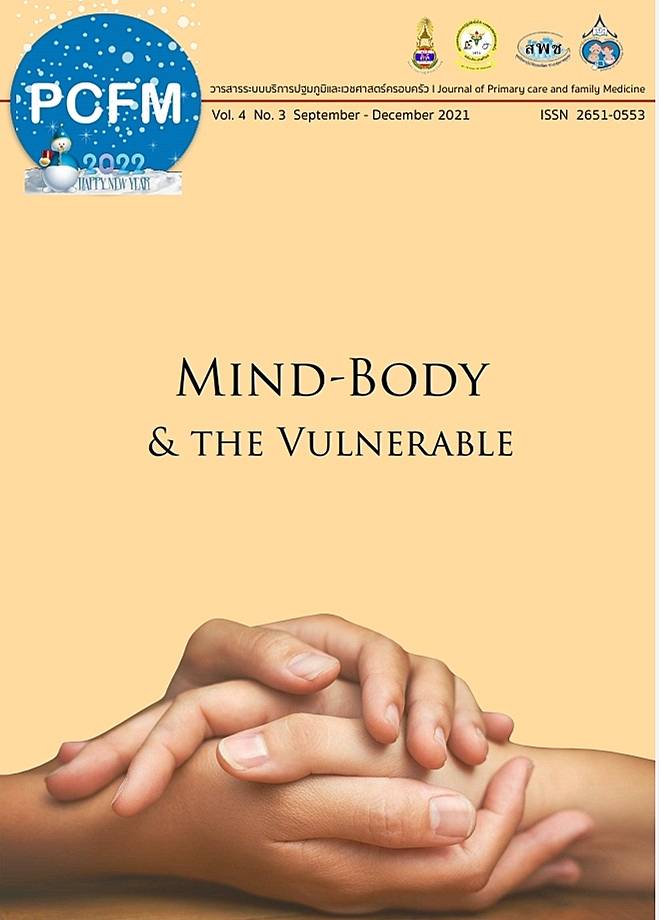การศึกษาเปรียบเทียบลักษณะและระยะเวลาการมีชีวิตของผู้ป่วยมะเร็งและผู้ป่วยที่ไม่ใช่มะเร็ง ที่ได้รับการส่งปรึกษาเพื่อการดูแลแบบประคับประคอง
Main Article Content
บทคัดย่อ
วัตถุประสงค์: เพื่อศึกษาความแตกต่างของลักษณะของผู้ป่วยและข้อมูลการส่งปรึกษาเพื่อการดูแลแบบประคับประคอง และเปรียบเทียบระยะเวลาการมีชีวิตระหว่างผู้ป่วยในกลุ่มโรคมะเร็งและกลุ่มที่ไม่ใช่โรคมะเร็ง
แบบวิจัย: การศึกษาเชิงวิเคราะห์แบบย้อนหลัง
วัสดุและวิธีการ: ทบทวนเวชระเบียนผู้ป่วยในที่ได้รับการส่งปรึกษาเพื่อการดูแลแบบประคับประคองมายังศูนย์ชีวาภิบาล โรงพยาบาลจุฬาลงกรณ์ สภากาชาดไทย ระหว่างวันที่ 1 สิงหาคม 2561 ถึงวันที่ 31 มีนาคม 2562
ผลการศึกษา: กลุ่มตัวอย่างจำนวน 247 ราย แบ่งเป็นกลุ่มผู้ป่วยโรคมะเร็งจำนวน 183 คน และกลุ่มผู้ป่วยที่ไม่ใช่โรคมะเร็งจำนวน 64 คน พบว่ากลุ่มผู้ป่วยที่ไม่ใช่โรคมะเร็งมีอายุเฉลี่ยสูงกว่า (72.6 ± 16.7 ปี และ 62.8 ± 15.5 ปี; p-value <0.001) ระดับความสามารถในการช่วยเหลือตัวเองต่ำกว่า (ร้อยละ 82.8 ต่อ ร้อยละ 68.3; p-value 0.026) ค่ามัธยฐานระยะวันนอนโรงพยาบาลรวมนานกว่า (40 วัน ต่อ 24 วัน; p-value 0.001) และค่ามัธยฐานระยะวันนอนโรงพยาบาลก่อนการส่งปรึกษานานกว่า (18 วัน ต่อ 9 วัน; p-value 0.001) เมื่อเปรียบเทียบกับกลุ่มผู้ป่วยโรคมะเร็ง เมื่อวิเคราะห์ด้วย survival analysis พบว่าระยะเวลาการมีชีวิตหลังการส่งปรึกษาในผู้ป่วยทั้งสองกลุ่มไม่มีความแตกต่างทางสถิติ (p-value 0.188)
สรุป: กลุ่มผู้ป่วยในที่ไม่ใช่โรคมะเร็งได้รับการส่งปรึกษาเพื่อการดูแลแบบประคับประคองล่าช้ากว่ากลุ่มผู้ป่วยในโรคมะเร็ง แต่ระยะเวลาการมีชีวิตหลังการส่งปรึกษาไม่แตกต่างกันระหว่างผู้ป่วยทั้งสองกลุ่ม
Article Details
เนื้อหาและข้อมูลในบทความที่ลงตีพิมพ์ในวารสาร PCFM ถือเป็นข้อคิดเห็นและความรับผิดชอบของผู้เขียนบทความโดยตรง ซึ่งกองบรรณาธิการวารสารไม่จำเป็นต้องเห็นด้วยหรือร่วมรับผิดชอบใด ๆ
บทความ ข้อมูล เนื้อหา รูปภาพ ฯลฯ ที่ได้รับการตีพิมพ์ลงในวารสาร PCFM ถือเป็นลิขสิทธิ์ของวารสาร PCFM หากบุคคลหรือหน่วยงานใดต้องการนำทั้งหมดหรือส่วนหนึ่งส่วนใดไปเผยแพร่ต่อหรือเพื่อกระทำการใด ๆ จะต้องได้รับอนุญาตเป็นลายลักษณ์อักษรจากวารสาร PCFM ก่อนเท่านั้น
เอกสารอ้างอิง
2. อากาศ พัฒนเรืองไล, บรรณาธิการ. List disease of palliative care and functional unit. นนทบุรี: กรมการแพทย์; 2559.
3. Knaul F, Radbruch L, Connor S, Lima Ld, Arreola-Ornelas H, Carniado OM, et al. How many adults and children are in need of palliative care worldwide? In: Connor SR, editor. Global atlas of palliative care. 2nd ed. London: Worldwide Hospice Palliative Care Alliance (WHPCA); 2020.
4. ชฎาพร สีลา, สุกัญญา หังสพฤกษ์, สาคร ภูน้ำเย็น, จุฑาทิพย์ พิทักษ์, สายใจ วอนขอพร, ชาลีมาศ ตันสุเทพวีรวงศ์, บรรณาธิการ. คู่มือการดูแลผู้ป่วยระยะสุดท้ายแบบประคับประคองสำหรับทีมหมอครอบครัว (Guidelines of palliative care for family care team). กรุงเทพฯ: สำนักงานหลักประกันสุขภาพแห่งชาติ; 2558.
5. Cochran WG. Sampling techniques. 3rd ed. New York: John Wiley & Sons; 1977.
6. Lau F, Downing M, Lesperance M, Karlson N, Kuziemsky C, Yang J. Using the palliative performance scale to provide meaningful survival estimates. Journal of Pain and Symptom Management. 2009;38(1):134-44.
7. Cantin B, Rothuisen LE, Buclin T, Pereira J, Mazzocato C. Referrals of cancer versus non-cancer patients to a palliative care consult team: do they differ? J Palliat Care. 2009;25(2):92-9.
8. Bostwick D, Wolf S, Samsa G, Bull J, Taylor DH, Johnson KS, et al. Comparing the palliative care needs of those with cancer to those with common non-cancer serious illness. Journal of Pain and Symptom Management. 2017;53(6):1079-84.e1.
9. Shih T-C, Chang H-T, Lin M-H, Chen C-K, Chen T-J, Hwang S-J. Differences in do-not-resuscitate orders, hospice care utilization, and late referral to hospice care between cancer and non-cancer decedents in a tertiary hospital in Taiwan between 2010 and 2015: a hospital-based observational study. BMC Palliat Care. 2018;17(1):18.
10. Fenstad ER, Shanafelt TD, Sloan JA, Novotny PJ, Durst LA, Frantz RP, et al. Physician attitudes toward palliative care for patients with pulmonary arterial hypertension: results of a cross-sectional survey. Pulmonary Circulation. 2014;4(3):504-10.
11. Ameena Mohammed A-A, Wafaa Mostafa A-E-G, Saleem Nawaf S, Sobhi Mostafa A. Knowledge and attitude of primary care physicians towards palliative care. Is it time for integration? Research Square [Preprint]. 2021.


